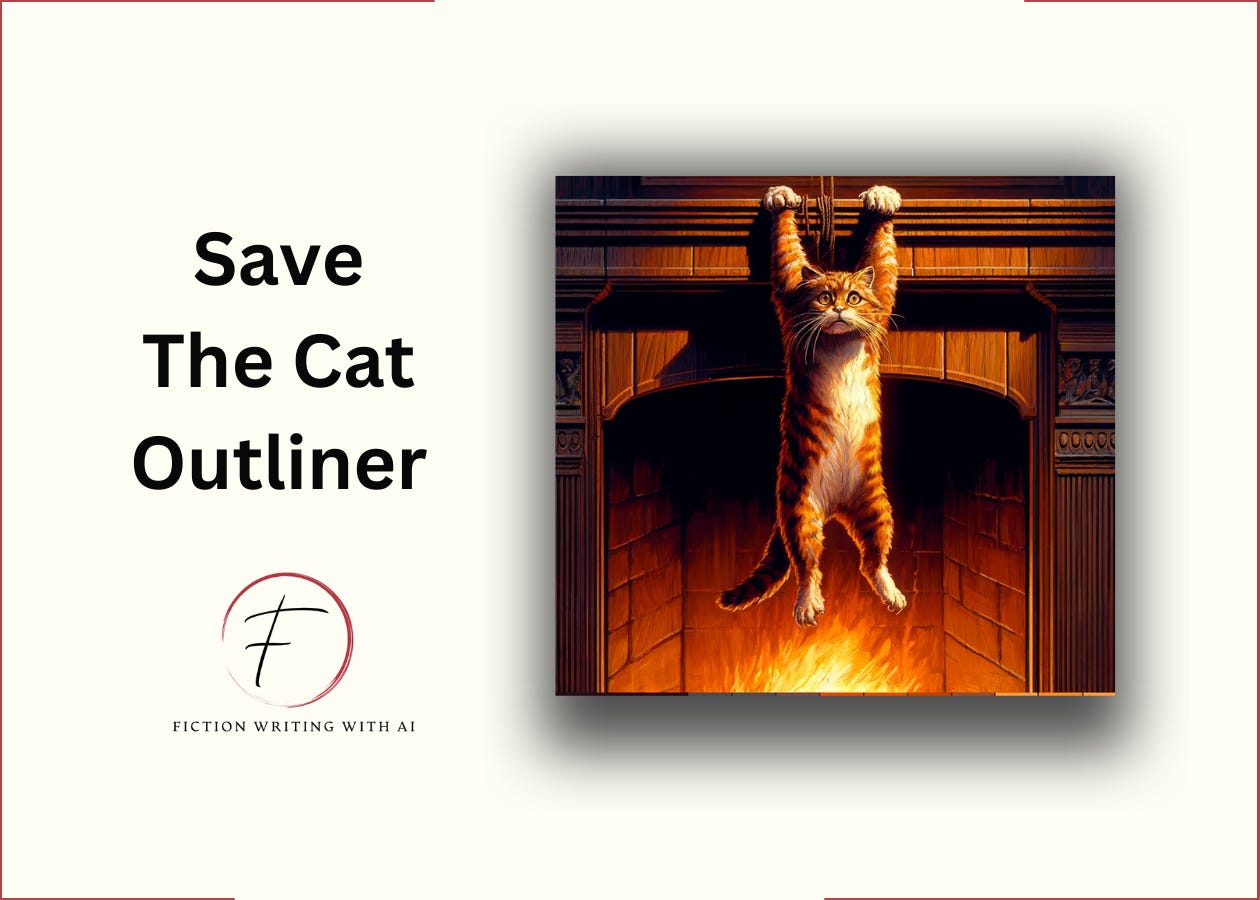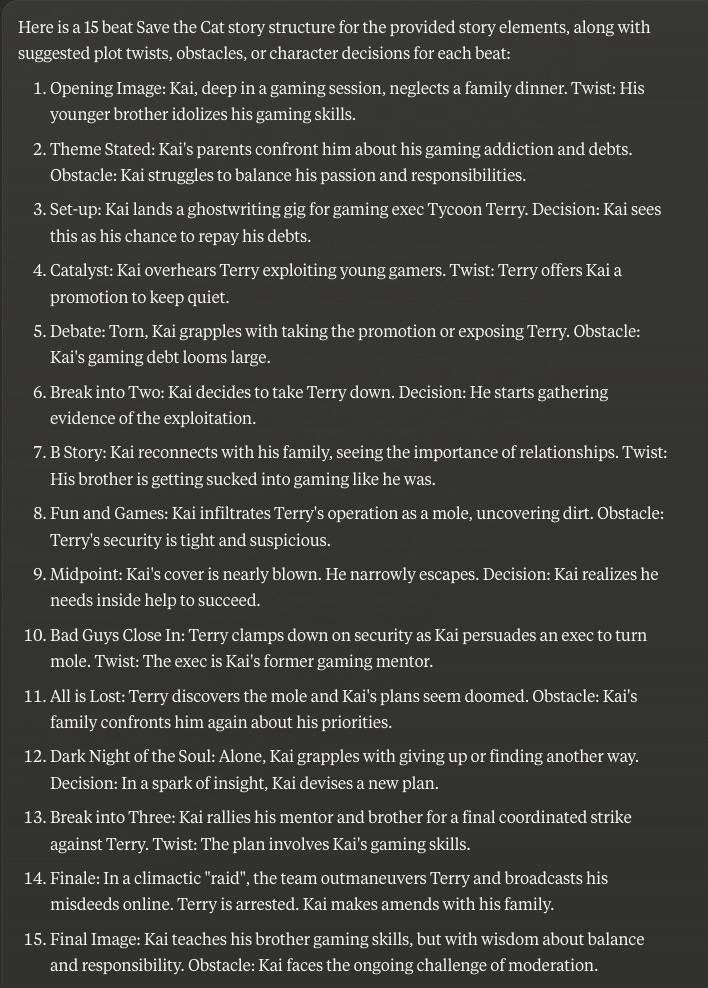Hey there!
Welcome back to the Zero to Book series!
In our last post, we laid the groundwork for your story by defining the The Story Core and exploring The Character Arc Triangle. By now, you should have a solid understanding of your protagonist, antagonist, and ally, and how their journeys will intersect.
But what comes next? How do you expand on the 5 elements in your Story Core?
The answer lies in plotting.
What Is Plotting And Why Is It Important?
Plotting maps out the events of your story.
It's the backbone of your narrative, ensuring that your story has a clear direction and purpose.
A well-plotted story:
Keeps readers engaged by maintaining a sense of tension and anticipation
Ensures a coherent narrative with a clear beginning, middle, and end
Drives character development and growth
Helps you, the writer, stay on track and avoid meandering storylines
Plotting turns your story idea into a book.
So, how do you go about plotting your novel?
Easy.
All you have to do is…
Save The Cat!
There are countless “plotting” methods out there, from the classic 3-Act Structure to Joseph Campbell's Hero's Journey. But today, we're going to focus on one of the most popular and user-friendly tools:
Blake Snyder's Save the Cat beat sheet
The Save the Cat method was created by screenwriter Blake Snyder, who published his book "Save the Cat! The Last Book on Screenwriting You'll Ever Need" in 2005. The title comes from a piece of advice Snyder gives in the book: if you want your audience to root for your protagonist, show them doing something likable early on, like saving a cat.
Snyder's beat sheet quickly gained popularity among screenwriters and novelists alike for its straightforward, easy-to-follow structure. The method breaks down your story into 15 key "beats" or plot points, serving as a roadmap from the opening image to the final resolution.
Many well-known stories, both on screen and in print, follow the Save the Cat structure.
Some examples include:
"The Hunger Games" by Suzanne Collins
"The Fault in Our Stars" by John Green
"The Help" by Kathryn Stockett
"The Martian" by Andy Weir
"The Proposal" (2009 film)
"Crazy Rich Asians" (2018 film)
These stories, while different in terms of genre and style, all follow the 15-beat structure outlined in Snyder's method.
So, why choose the Save the Cat method over others? Here are a few reasons:
It's simple and easy to understand, making it perfect for first-time novelists
It's flexible and can be adapted to fit any genre or story type
It helps you avoid common pitfalls like uneven pacing or a lack of character growth
Plus, by following the beat sheet, you'll be in good company. Countless hit novels and screenplays have used this structure to great success.
Alright, let's dive into the beats themselves.
The 15 Beats Of The Save The Cat Method
Before we dive into the specific beats, let's take a moment to understand what a "beat" actually is in the context of storytelling.
In essence, a beat is a significant moment or plot point in your story that propels the narrative forward. It's a key event or decision that alters the course of your protagonist's journey, either by introducing a new conflict, revealing important information, or spurring character growth.
Beats are the foundation of your story, each contributing to the overall narrative structure.
Here's a quick overview of each one and how they function in your story:
Opening Image: This is the first impression of your protagonist's world. It sets the tone and hints at the themes to come.
Theme Stated: Somewhere in the first few pages, your story's central question or theme is introduced, usually in dialogue.
Setup: This beat establishes your protagonist's life before the main conflict takes hold. It's a chance to introduce key characters and settings.
Catalyst: Here's where things get interesting! The catalyst is the event that kicks your story into gear, disrupting your protagonist's status quo.
Debate: Faced with this new challenge, your protagonist hesitates. They debate whether to take action or stick with what's familiar.
Break into Two: Your protagonist makes a choice and enters a new world or situation. This marks the end of Act 1.
B Story: A secondary plot line emerges, often involving a romantic interest or a key ally.
Fun and Games: Your protagonist explores their new surroundings and faces initial challenges. This beat often includes some of the story's most memorable and entertaining moments.
Midpoint: Halfway through the story, a major twist or revelation occurs that raises the stakes and shifts the story's direction.
Bad Guys Close In: The antagonistic forces gain the upper hand, putting pressure on your protagonist.
All Is Lost: Your protagonist hits rock bottom. They experience a major loss or setback that seems insurmountable.
Dark Night of the Soul: In the wake of their loss, your protagonist reflects on their journey so far. This introspection leads to a crucial realization or change.
Break into Three: Armed with new knowledge or resolve, your protagonist devises a plan to confront the antagonist and resolve the central conflict.
Finale: Your protagonist faces off against the antagonist in a final battle or challenge. This is the climax of your story.
Final Image: The dust settles, and we see your protagonist's new life post-resolution. This beat provides closure and leaves a lasting impression on the reader.
Adapt The “Beats” To Your Genre
One of the beauties of the Save the Cat method is its flexibility.
While the 15 beats provide a general framework, they can be tailored to suit any genre or story type. For example, in a romance novel, the “Midpoint” could be a moment where the love interests share a passionate kiss, cementing their feelings for each other and raising the stakes of their relationship. And in a mystery thriller, the Midpoint might reveal a clue that shifts the direction of the investigation and puts the protagonist on a collision course with the killer.
The general function of the Midpoint beat remains the same—to introduce a major twist or revelation that raises the stakes and shifts the story's direction. But, the specific manifestation of that beat can vary widely depending on the genre.
The same principle applies to the other beats as well.
The key is to understand the purpose of each beat and adapt it to fit your story's unique needs. Ask yourself:
What is the essential function of this beat in my story?
How can I manifest that function in a way that feels organic to my genre and characters?
What are the conventions and expectations of my genre, and how can I subvert or satisfy them at this particular point in the story?
Using the beat sheet helps you hit the right story points to engage readers.
And it provides a structure to unleash your creativity within.
Put The Beat Sheet Into Action With AI
Now that you understand the basics of the Save the Cat method, let's apply it to the Story Core we developed in our last post—but with a twist.
Let's use AI to quickly create your beat sheet, helping you draft ideas in minutes rather than figuring out all 15 beats by yourself. To get started, all you need is your completed Story Core worksheet from our previous post.
This should include:
Your protagonist, their desire, and their flaw
The central conflict and stakes
Your antagonist and ally
The general arc of your story (e.g., "and they succeed," "and they fail," etc.)
Once you have your Story Core ready, simply plug it into the following prompt:
Using the Save the Cat beat sheet, generate the 15 beats for a story with the following core elements:
{Insert Your Story Core}
For each beat, suggest a potential plot twist, obstacle, and character decision that could occur.
Let's try it out with the Story Core we've been working with:
Using the Save the Cat beat sheet, generate the 15 beats for a story with the following core elements:
Kai, a gamer and former loot box addict turned gaming exec ghostwriter, wants to repay his gaming debt to his parents and regain their trust. But when he discovers his client, Tycoon Terry, is exploiting young gamers, Kai must level up and organize a raid to take Terry down. With the help of a disillusioned gaming exec acting as a mole, Kai ultimately succeeds, exposing the corrupt execs and making amends with his parents. Throughout the story, Kai must learn to value real-world relationships over virtual ones.
For each beat, suggest a potential plot twist, obstacle, or character decision that could occur.
Run this prompt through your favorite AI writing tool, and voila!
In seconds, you'll have a full 15-beat outline, complete with plot twists and character moments, all tailored to your specific Story Core.
Remember, the AI's output is just a starting point.
Read through the generated beat sheet, pick and choose the ideas that resonate with you, and don't be afraid to make changes or additions as needed. The goal is to use the AI as a creative partner, not to let it dictate your entire story.
As you work through the beats, keep your Story Core and Character Arc Triangle in mind. Every plot point should serve to advance your protagonist's journey and bring them closer to their ultimate goal. And don't worry if your first attempt at plotting feels a bit rough around the edges. Plotting is an iterative process, and you'll likely go through multiple drafts before landing on the perfect structure for your story.
In our next series of posts, we'll dive into the next stage of the novel-writing process: fleshing out your plot with scene-by-scene details and rich character development.
Until then, happy plotting!
Chat soon!
–Nicolas Cole





